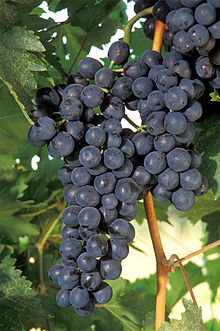Grape

| Noble grapevine | ||
|---|---|---|

Black- blue berries with a cross section of a berry. Red dyes are almost always only contained in the berry peel. |
||
| Systematics | ||
|
||
| Scientific name | ||
| Vitis vinifera | ||

Grapes are the fruit bunches of grapevines ( Vitis ), especially those of the noble grapevine ( Vitis vinifera subsp. Vinifera ). The individual fruits of the fruit cluster are called grapes . Colloquially, a clear distinction is not always made between berries and grapes. From a botanical point of view, however, the shape of the fruit cluster with branched side axes is not a grape , but a panicle . In the technical jargon of viticulture , the inflorescences are called Gescheine .
The climbing vine is one of the oldest cultivated plants known to man. Today around 16,000 grape varieties are known. There are grapevines with green or yellow (“white”) berries and those with red to dark blue (“red”) berries. These are spherical to ovoid in shape and have a diameter of 6 to 20 millimeters.
Grapes can be eaten raw ( table grapes ), dried with raisins and with wine , brandy , grape juice, etc. Ä. processed ( wine grapes ). Pomace - the residue left over from winemaking - is used in particular to make brandies. A very well-known pomace brandy is the Italian grappa .
The peel and the kernel of the grapes contain oligomeric proanthocyanidins (OPCs). a. act as powerful antioxidants ; the seeds can be processed into grape seed oil and grape seed flour . The seeds and the skin of the berries are also a source of the antioxidant resveratrol .
Seedless grapes are created by artificially induced parthenocarpy (virgin fruitiness ).
Wine is created in the course of the production process through alcoholic fermentation . Musts or mashes are produced from the grapes by pounding or pressing ( wine press ) , which are then fermented into wine.
Average composition
The composition of grapes naturally fluctuates, both depending on the environmental conditions (soil, climate) and the cultivation technique (fertilization, plant protection).
Details per 100 g of edible portion:
|
|
|
|
The main components of the berry flesh are glucose and fructose , as well as tartaric and malic acids .
1 mg = 1000 µg
1 semi-essential
The physiological calorific value is 287 kJ (68 kcal) per 100 g of edible portion.
Economical meaning
The following table gives an overview of the 20 largest producers of grapes worldwide, who produced a total of 87.7% of the harvest.
| rank | country | Quantity (in t ) |
rank | country | Quantity (in t) |
|
|---|---|---|---|---|---|---|
| 1 |
|
13,397,012 | 11 |
|
1,901,736 | |
| 2 |
|
8,513,643 | 12 |
|
1,759,472 | |
| 3 |
|
6,890,970 | 13 |
|
1,663,557 | |
| 4th |
|
6,673,481 | 14th |
|
1,591,986 | |
| 5 |
|
6,198,323 | 15th |
|
1,589,784 | |
| 6th |
|
3,933,000 | 16 |
|
1,403,597 | |
| 7th |
|
2,920,000 | 17th |
|
1,144,305 | |
| 8th |
|
2,573,311 | 18th |
|
984.081 | |
| 9 |
|
2,500,000 | 19th |
|
933.150 | |
| 10 |
|
2,032,031 | 20th |
|
778,698 | |
| world | 79.125.983 |
For comparison, the values for Austria (367,131 t) and Switzerland (107,776 t).
see also:
toxicology
Grapes are non-toxic to many animals. In some dogs , however, grape poisoning occurs even after ingesting 10 grams of grapes per kilogram of body mass .
literature
- Bernd Altmayer: Changes in the constituents of grape musts and mycotoxin formation by types of fungi colonizing grapes. Dissertation at the University of Kaiserslautern , Kaiserslautern 1982.
- Gemmrich: Application-oriented research and development at universities of applied sciences: Development of an optisensor for automatic quality control when grapes are delivered to the press. (Short title: Optisensor for grapes; final report according to No. 3.2 BNBest-BMBF. ) Heilbronn University of Applied Sciences , Heilbronn 1999.
Web links
Ingredients of grapes Link collection on the topic (resveratrol, anthocyanins, catechins and quercetin)
Individual evidence
- ↑ Christoph Drösser : Isn't that right ?: Der Traube Kern. Rubric: Knowledge. In: Zeit Online . Zeitverlag Gerd Bucerius , December 4, 2003, accessed on March 15, 2015 (from: Die Zeit . No. 50/2003).
- ↑ German Research Institute for Food Chemistry (DFA), Garching (Hrsg.): Food table for practice . The little souci · specialist · herb. 4th edition. Wissenschaftliche Verlagsgesellschaft mbH, Stuttgart 2009, ISBN 978-3-8047-2541-6 , p. 239 .
- ^ A b Crops> Grapes. In: Official FAO production statistics for 2018. fao.org, accessed on March 13, 2020 .
